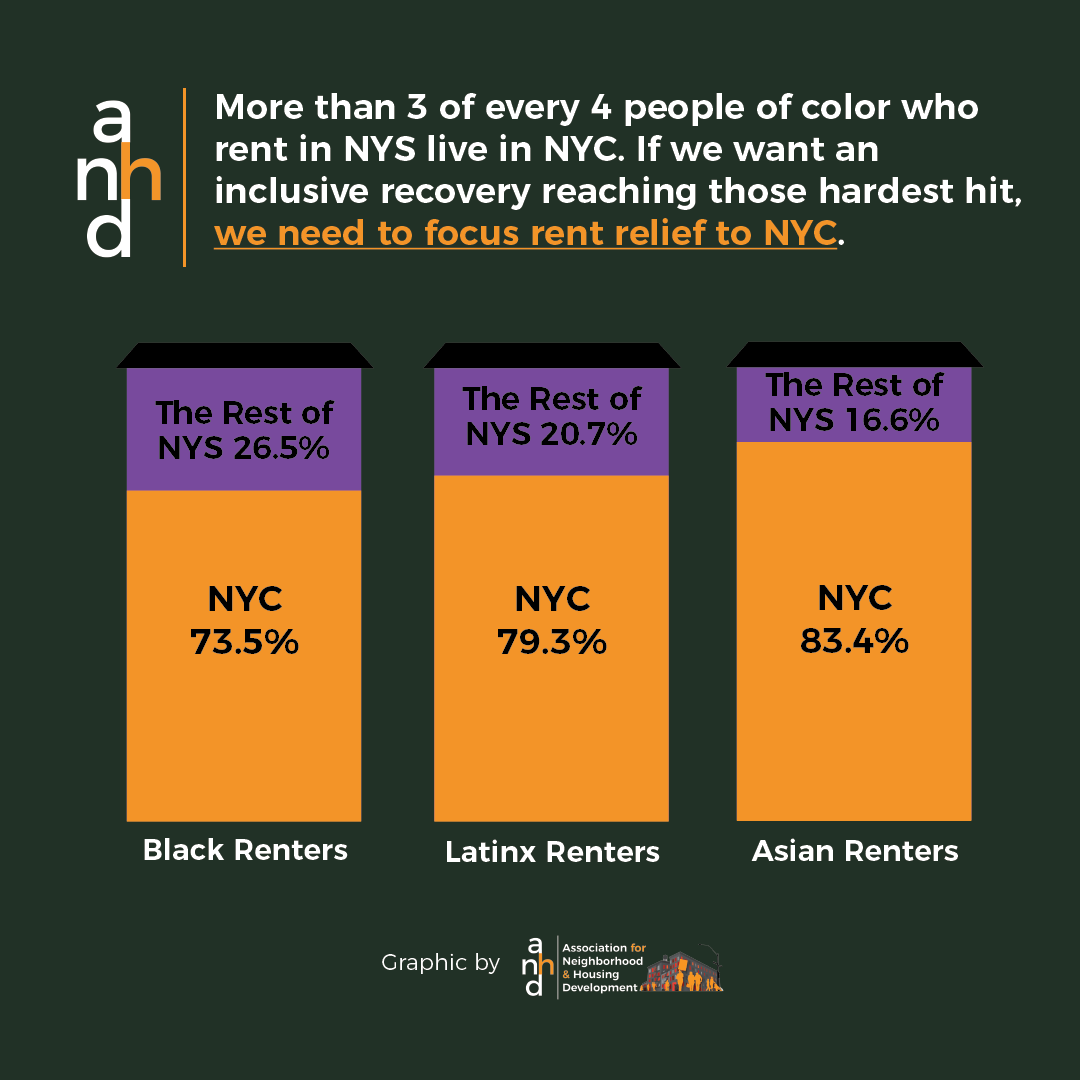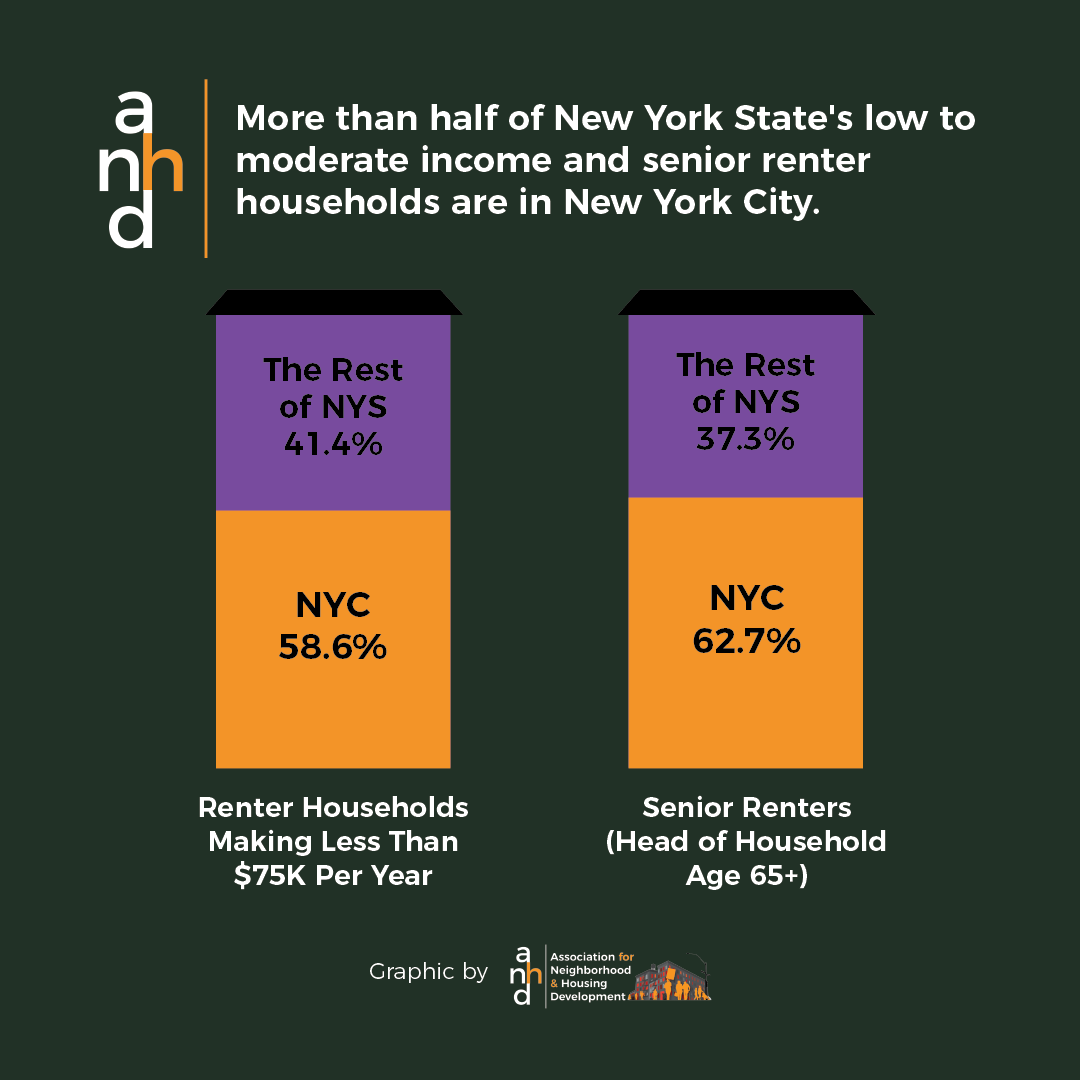New York City’s Unfair Share
ANHD Analysis Shows the COVID Rent Relief Package Will Miss Renters Who Need It Most
As President Joe Biden enters office with the intention of working with Congress to get more desperately needed relief to Americans, it is critical that the government directs that relief to where it is needed most. In the final days of 2020, Congress passed a COVID-19 relief package that included $25 billion for rent relief, marking the first federal aid to America’s millions of renters in nearly 10 months. While the $1.3 billion that New York State is expected to receive will only meet a fraction of the need, we thank our elected officials and partners across the country who have and will continue to fight for tenants.
At the same time, ANHD is concerned about the inequitable distribution of rent relief: even though the vast majority of the state’s renters live in New York City, the city is slated to receive less than 20% of that desperately needed relief. New York City has less than half (43%) of New York State’s population, but it has a dramatically higher proportion of renters. We are, predominantly, a renter’s city: two-thirds of New York City’s households rent compared to 30% of households in the rest of New York State. As a result of this uneven distribution, New York City has 63% of all the renters in the state.
The December 2020 COVID-19 relief package allocates emergency rental assistance using the same formula as set in the March 2020 CARES Act to states and directly to some localities. For localities, including New York City, direct allocations are 45% of the state population.[1]
Based on the legislation’s formula, New York City is set to receive just 19.4% of the state’s rent relief, an unfair share given that New York City houses 63% of New York State’s renters.

If New York City’s share of emergency rent relief mirrored its share of renters, the city’s allocation would more than triple from $252 million to $819 million.
This unfair share becomes even clearer when we look at our most marginalized renters. Strikingly, New York City houses 73.5% of all Black renters, 79.3% of all Latinx renters, and 83.4% of all Asian renters in New York State. Since the beginning of the pandemic, people of color have been disproportionately impacted by the worst effects of the COVID-19 crisis, from job loss to the loss of human life, and rent relief efforts should be specifically directed to those populations – not away from them. We cannot allow our desire to quickly move resources and aid to recreate the racial inequities our policies have maintained for so long.
More than three in four people of color who rent in the state live in New York City; when we underfund New York City, we are harming New Yorkers of color.

New York City also has more than half of the state’s senior and low to moderate income renters. New York City houses 62.7% of senior renters and 58.6% of renter households earning less than $75,000 in annual income. Our seniors are particularly vulnerable during this pandemic; many are on fixed incomes and face higher risks of severe complications and death due to COVID-19. Similarly, our low-income renters do not have savings, investments, or assets in a time of economic crisis.

The use of the CARES Act formula for rent relief distorts and hinders New York City’s ability to meet the needs of impacted renters. This is further compounded by New York City’s higher rents – the median gross rent in New York City is $1,443 versus $1,280 statewide. With higher rents, aid will cover less household rent arrears than in other parts of the state.
Upstate, Monroe and Erie counties have also applied for direct allocations. Like New York City, their urban centers Rochester and Buffalo are mostly comprised of renters: 63.6% of Rochester households and 59.3% of Buffalo households rent. To be equitable, rent relief across New York State must be calibrated proportionally to renter populations.
Our ability to support and serve our city’s struggling renters is directly connected to our ability to get them the relief they so desperately need and deserve. Without a fair share, New York City’s community developers, supportive housing providers, first-time homeowner landlords, and small landlords will not have access to emergency resources they need to keep their strained buildings in operation and families safely in their homes. If our state legislators and Governor Cuomo do not direct additional statewide rent relief funding to New York City and other localities with large renter populations, rent relief funding will miss New York’s renters who need it the most.
In future rent relief packages, the Biden Administration and Congress must correct the formula for rent relief to ensure equity. Immediately, New York State can take action to remedy the disparity of December’s relief package. The 19.4% allocation towards rent relief in New York City is a floor, not a ceiling, and ANHD calls on our state legislators and Governor Cuomo to ensure rent relief funding reaches New York City and other renter-dense parts of New York State in proportion to their great need.
Data sources: All statistics in this blog come from the American Community Survey 2019 5-Year Estimates.
[1] Consolidated Appropriations Act 2021, §501(b), https://templates.legal/consolidated-appropriations-act/, and 42 US Code §801(c)(5), https://www.law.cornell.edu/uscode/text/42/801